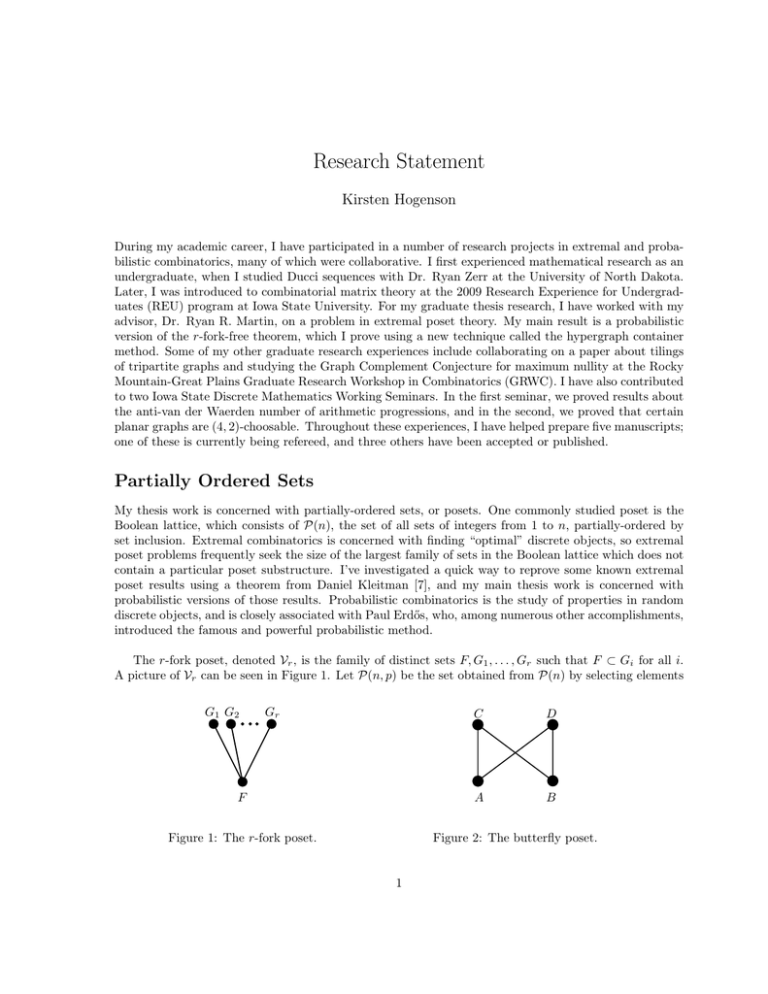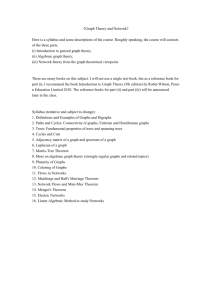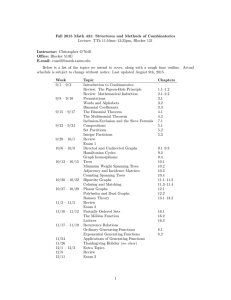Research Statement Kirsten Hogenson
advertisement

Research Statement
Kirsten Hogenson
During my academic career, I have participated in a number of research projects in extremal and probabilistic combinatorics, many of which were collaborative. I first experienced mathematical research as an
undergraduate, when I studied Ducci sequences with Dr. Ryan Zerr at the University of North Dakota.
Later, I was introduced to combinatorial matrix theory at the 2009 Research Experience for Undergraduates (REU) program at Iowa State University. For my graduate thesis research, I have worked with my
advisor, Dr. Ryan R. Martin, on a problem in extremal poset theory. My main result is a probabilistic
version of the r-fork-free theorem, which I prove using a new technique called the hypergraph container
method. Some of my other graduate research experiences include collaborating on a paper about tilings
of tripartite graphs and studying the Graph Complement Conjecture for maximum nullity at the Rocky
Mountain-Great Plains Graduate Research Workshop in Combinatorics (GRWC). I have also contributed
to two Iowa State Discrete Mathematics Working Seminars. In the first seminar, we proved results about
the anti-van der Waerden number of arithmetic progressions, and in the second, we proved that certain
planar graphs are (4, 2)-choosable. Throughout these experiences, I have helped prepare five manuscripts;
one of these is currently being refereed, and three others have been accepted or published.
Partially Ordered Sets
My thesis work is concerned with partially-ordered sets, or posets. One commonly studied poset is the
Boolean lattice, which consists of P(n), the set of all sets of integers from 1 to n, partially-ordered by
set inclusion. Extremal combinatorics is concerned with finding “optimal” discrete objects, so extremal
poset problems frequently seek the size of the largest family of sets in the Boolean lattice which does not
contain a particular poset substructure. I’ve investigated a quick way to reprove some known extremal
poset results using a theorem from Daniel Kleitman [7], and my main thesis work is concerned with
probabilistic versions of those results. Probabilistic combinatorics is the study of properties in random
discrete objects, and is closely associated with Paul Erdős, who, among numerous other accomplishments,
introduced the famous and powerful probabilistic method.
The r-fork poset, denoted Vr , is the family of distinct sets F, G1 , . . . , Gr such that F ⊂ Gi for all i.
A picture of Vr can be seen in Figure 1. Let P(n, p) be the set obtained from P(n) by selecting elements
G1 G2
Gr
F
Figure 1: The r-fork poset.
C
D
A
B
Figure 2: The butterfly poset.
1
independently at random with probability p. I’ve proved the following theorem regarding the size of the
largest Vr -free set in P(n, p).
Theorem 1. If p n1 , then with high probability, the largest Vr -free set in P(n, p) has size at most
n
(1 + o(1))p bn/2c
. If p n1 , then with high probability, the largest Vr -free set in P(n, p) has size at least
n
(2 − o(1))p bn/2c .
In essence, this result says that when p is ‘big’, the largest r-fork-free set in P(n, p) will be about
as large as expected, and when p is ‘small’, the largest r-fork-free set in P(n, p) will be much bigger
than expected. The threshold which determines if p is ‘big’ or ‘small’ is p̂ = n1 . I’m currently working
on an analogous result for the butterfly poset, which is the family of distinct sets A, B, C, D such that
A ∪ B ⊆ C ∩ D. A picture of the butterfly can be seen in Figure 2.
The technique for proving Theorem 1 is referred to as the hypergraph container method. It was
developed independently by Balogh, Morris and Samotij [3] and by Saxton and Thomason [8]. The
general idea behind the hypergraph container technique is to show that all the sets we are concerned with,
in my case these are Vr -free sets, are contained in a small number of sets with some special properties.
Then we show that the probability of a container set being too large is very small, which implies that the
Vr -free sets are also unlikely to be large. In the case of Vr -free sets, I was able to encode my poset family
in a directed graph before applying the container technique. However, for more structured posets like
the butterfly, the poset family must be encoded into a hypergraph, which makes applying the container
technique much more complex.
Graph Tiling
Before beginning my thesis research, I worked with Dr. Ryan R. Martin and Dr. Yi Zhao on the paper
Tiling tripartite graphs with 3-colorable graphs: The extreme case. An H-tiling of a graph G is a subgraph
consisting of vertex disjoint copies of a graph H, and graph tiling problems like the one in this paper
ask which constraints on G’s properties will maximize the number of copies of H in the tiling. For an
example of a graph tiling, see Figure 3, which shows a perfect tiling of the complete tripartite graph
K2,2,2 by copies of P2 , the path on two vertices. The main result of this paper is presented in Theorem 2.
Figure 3: A perfect tiling of K2,2,2 by blue colored copies of P2 .
Theorem 2 ([6]). If G is a balanced tripartite graph on 3N vertices for N sufficiently large, and each
vertex is adjacent to at least 2N/3 + 2h − 1 vertices in each of the other classes, then G can be tiled
perfectly by copies of Kh,h,h .
This degree bound is shown to be tight in certain cases, and we give a configuration for the graphs
which achieve the bound. Though this manuscript is still in progress, we intend to submit the paper in
early 2016.
2
Combinatorial Matrix Theory
Some very valuable experiences I have had with collaborative research, networking, and professional development were at the Iowa State Research Experience for Undergraduates (REU) program and the 1st
and 2nd annual Graduate Research Workshops in Combinatorics (GRWC). The REU was a two-month
research opportunity where I worked with other undergraduates on a project in combinatorial matrix
theory led by Dr. Leslie Hogben. Combinatorial matrix theory combines combinatorics, graph theory
and linear algebra to study patterns of entries in families of matrices described by combinatorial objects
like graphs. My REU group looked at the minimum rank of matrices corresponding to graphs in two particular families, which we referred to as ciclos and estrellas, and our resulting paper was titled Minimum
rank, maximum nullity and zero forcing number for selected graph families [2].
The GRWC meetings were intense, two-week workshops for graduate students where I contributed
to multiple research projects, including another problem in combinatorial matrix theory. This project
group worked toward the Graph Complement Conjecture for maximum nullity M (G) of a graph, which
concerns the following inequality:
M (G) + M (G) ≥ |G| − 2.
To this end, we define the counterprism of G to be the disjoint union of G, its complement G and a perfect
matching between the corresponding vertices of G and G. One of our preliminary results, presented in
Theorem 3, states that the zero forcing number of a counterprism graph must be one of two values. This
is significant since the zero forcing number of a graph is an upper bound for its maximum nullity.
Theorem 3 ([1]). The zero forcing number of the counterprism of G is either |G| − 1 or |G|.
We have other results regarding bounds for the maximum nullity of the counterprism and are continuing to collaborate on this project.
Coloring Problems
During the past two academic years, the Iowa State Discrete Mathematics Seminar has hosted a working
seminar. The first of these working seminars studied the anti-van der Waerden properties of arithmetic
progressions in subsets of finite abelian groups. In particular, we worked to find aw(S, k), the smallest number of colors required to ensure that a coloring of S will contain a rainbow k-term arithmetic
progression. Notably, we found very different results for k = 3 and k ≥ 4, as presented in Theorem 4.
Theorem 4 ([5]). Let [n] := {1, . . . , n} and k ≥ 4. Then aw([n], 3) = Θ(log n) and aw([n], k) = n1−o(1) .
This says that for large n, the number of colors needed to guarantee that [n] contains a rainbow k-term
arithmetic progression is much larger for k ≥ 4 than it is for k = 3. This and other results have been
accepted for publication by Journal of Combinatorics in a paper titled Rainbow arithmetic progressions.
The second working seminar was led by Dr. Derrick Stolee, and we studied (4, 2)-choosability of
planar graphs. This is a list coloring problem that asks which graphs can be properly colored when each
vertex’s color comes from a list of size 4, and the color lists for adjacent vertices have at most 2 common
colors. Note that in a proper graph coloring, adjacent vertices are assigned different colors. Our main
results are summarized below in Theorem 5.
Theorem 5 ([4]). A graph G is (4, 2)-choosable if it avoids any of the three following substructures:
chorded 5-cycles, chorded 6-cycles and chorded 7-cycles.
3
Our primary proof technique was the discharging method, which assigns charge to the vertices and
faces of a planar graph, then moves that charge around in an effort to contradict Euler’s formula. We
have submitted a manuscript titled (4,2)-choosability of planar graphs with forbidden substructures to
Graphs and Combinatorics.
Future Plans
During my time as a student, I’ve worked with many talented co-authors on research projects that were
performed in a variety of different formats. A handful of those projects are ongoing, and I am still
working, both individually and with colleagues, on problems in extremal poset theory, graph tiling, and
combinatorial matrix theory. As I’ve gained experience, I have taken on leadership roles in many projects,
and I believe I’m ready to act as a leader to undergraduate researchers. Conducting research as an
undergraduate was extremely valuable to me because it ignited my love of problem-solving and convinced
me that I wanted to pursue a graduate degree in mathematics. I’d like to help other undergraduates
get that experience, and I think that many elements from my collaborative experiences, particularly the
Iowa State REU and GWRC formats, could be applied to undergraduate research. The idea of working
on research with undergraduates is really exciting to me, and I look forward to the opportunity to share
my enthusiasm for mathematics with budding future mathematicians.
References
[1] A. Abiad, P. DeOrsey, H. Hogben, K. Hogenson, F. Kenter, J.C.-H. Lin, S. Loeb, H. Smith and M.
Young. Zero forcing number on the counterprism of graphs, in progress.
[2] E. Almodovar, L. DeLoss, L. Hogben, K. Hogenson, K. Murphy, T. Peters and C.A. Ramı́rez,
Minimum rank, maximum nullity and zero forcing number for selected graph families. Involve 3
(2010), no. 4, 371–392.
[3] J. Balogh, R. Morris and W. Samotij, Independent sets in hypergraphs. J. Amer. Math. Soc. 28
(2015), no. 3, 669–709.
[4] Z. Berikkyzy, C. Cox, M. Dairyko, K. Hogenson, M. Kumbhat, B. Lidický, K. Messerschmidt, K.
Moss, K. Nowak, K. Palmowski and D. Stolee. (4,2)-choosability of planar graphs with forbidden
substructures, submitted to Graphs and Combinatorics, 33pp. arXiv:1512.03787.
[5] S. Butler, C. Erickson, L. Hogben, K. Hogenson, L. Kramer, R.L. Kramer, J.C.-H. Lin, R.R. Martin,
D. Stolee, N. Warnberg and M. Young. Rainbow arithmetic progressions, to appear in Journal of
Combinatorics, 21pp. arXiv:1404.7232.
[6] K. Hogenson, R.R. Martin and Y. Zhao. Tiling tripartite graphs with 3-colorable graphs: The
extreme case, in progress.
[7] D. Kleitman, A conjecture of Erdős-Katona on commensurable pairs among subsets of an n-set. 1968
Theory of Graphs (Proc. Colloq., Tihany, 1966) pp. 215–218 Academic Press, New York.
[8] D. Saxton and A. Thomason, Hypergraph containers. Invent. Math. 201 (2015), no. 3, 925–992.
4



